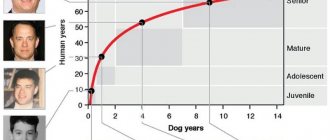Estrus, or estrus, in domestic animals is a natural mechanism for procreation. The complex process is controlled by hormones and normally lasts no more than 3 weeks. If heat lasts more than 21 days, experienced dog breeders and veterinarians talk about prolonged estrus in dogs. This phenomenon negatively affects the fertilization of the female. Read about the causes of prolonged estrus, types and treatment further in our article.
Causes of prolonged estrus in dogs
According to veterinary experts, prolonged estrus may also indicate serious health problems in the dog.
In veterinary practice, the reasons that provoke disruption of the female’s reproductive cycle in the direction of increasing its duration include the following factors:
- Chronic inflammatory processes in the reproductive system. Endometritis, purulent inflammation of the uterus, and genital infections most often, according to veterinary experts, lead to prolonged estrus in domestic animals.
- Diseases of the thyroid gland and pituitary gland can disrupt the normal reproductive process in the female body. The mechanism of pathology in this case is associated with a failure in the production of hormones that have a direct or indirect effect on the proliferative processes in the uterus during estrus.
- Neoplasms in the genital organs. Tumors of the uterus, cystic formations in the ovaries, and cancerous lumps in the mammary glands are no less common causes of estrus disturbances in dogs after inflammatory processes.
- In some cases, the cause of prolonged estrus in a pet may be chronic stress or a history of using contraceptive hormonal drugs.
Hormonal contraceptives
- Vitamin deficiencies and exhaustion of the animal can lead to pathology.
The mechanism of development of the disease ultimately occurs due to the overproduction of female sex hormones . An excessive concentration of estrogen in the female’s blood leads to morphological changes occurring in the uterus. Hyperplasia develops in the tissues of the organ, which leads to pathological thickening of the endometrium and provokes chronic endometritis.
A change in the morphology of the epithelium leads to an extension of the estrus period. Veterinary specialists attribute the pathology to endocrine disruption associated with morphological disorders in the structure of the uterine epithelium.
According to breeders, problems with prolonged estrus are most often observed in boxers and poodles.
We recommend reading about when dogs go into heat. From the article you will learn when a dog’s first heat begins, the symptoms of its onset, and the characteristics of small and large breeds.
And here is more information about the causes and treatment of ovarian cysts in dogs.
Types of protracted estrus
In veterinary practice, there are four main types of pathological sexual heat:
- 1 type . Characterized by proestrum prolongation up to 3 weeks. During this period, the female is attractive to males and causes their excitement. The dog's external genitalia are swollen. The owner may observe a watery pink-red discharge.
- Type 2 This type of pathology is characterized by an extended proestrum phase and is most often diagnosed in middle-aged individuals. Unlike the first type, with this type of disease males do not become excited upon contact with a female. Against the background of swollen genitals, the dog has slight red-brown, sometimes dirty discharge.
- In some cases, a sick animal is bothered by severe itching. The dog constantly licks the perineal area, which leads to bald patches.
- Type 3 Prolonged estrus period (more than 12 days). According to the observations of experienced breeders, females aged 5-7 years are more often susceptible to the disease. A sick individual may experience pseudolactation, accompanied by severe thirst. Unlike previous estrus disorders, during a prolonged estrus period, discharge from the external genitalia of the dog is practically not detected, or it is mucous in nature.
- 4 type . Characterized by an extended metoestrum phase. The pathology is common in young animals. Vaginal discharge is serous, and in some cases purulent. The dog's condition is depressed and there is increased thirst.
Some experts also distinguish the so-called split estrus, when after fertilization, 3-6 days later, the dog again shows signs of sexual heat.
Symptoms of disorders
Each type of hormonal disorder is characterized by specific clinical signs. Veterinary experts recommend that owners pay attention to the general symptoms of prolonged estrus in a dog , on which the treatment of the pathology will depend:
- Lengthening the female's sexual desire phase.
- Pseudolactation. Under the influence of estrogen, breast tissue swells and a milky fluid may ooze from the nipples.
- Vaginal discharge. Their character depends on the type of prolonged estrus. The owner can observe both scanty mucous discharge and copious discharge of a purulent nature.
- Skin lesions. The discharge leads to maceration of the skin and causes itching, which provokes the dog to lick the affected area.
Most often, the owner encounters areas of baldness, redness and rashes on the external genital organs of the animal.
In some cases, during prolonged estrus, increased thirst, lethargy, and deterioration of the coat are observed.
Watch this video on how to determine if your dog is in heat:
Answer
It is believed that every second person has a pet. As a rule, most people prefer dogs. Pets are not at all problem-free creatures of nature. on the contrary, they are often capable of causing a considerable amount of trouble to the owner and people around him.
For example, a common concern among bitch owners is that they are in heat. The owner is very concerned about the timing of the emptying process, as the process is commonly called among veterinarians.
Each dog is individual; accordingly, the hormonal background and internal structure do not lend themselves to strict classification. The veterinarian is not able to create a specific schedule for the dog's heat. The doctor has the right to offer only a common and general description of the process.
For example, in small dogs, empty nesting begins at six months. Representatives of the Chihuahua breed mature early, and by the time they are one year old they are considered hormonally quite mature ladies. Large shepherds mature around two years. However, an inaccuracy crept into the statement. This breed is capable of distinguishing itself; one of the representatives will suddenly become a fully grown lady before reaching a year old. The fact only confirms that estrus is an unpredictable process, the outcome of which is known only to nature.
Consequences for the dog
Pathology of the reproductive cycle, which is based on hormonal imbalance, according to veterinary specialists and experienced breeders, can lead to the following consequences:
- Development of chronic endometritis with subsequent development of infertility.
- Infection of the reproductive organs with pathogenic microflora due to a violation of the local protection of the mucous membrane. Vaginal discharge is an excellent breeding ground for viruses and bacteria.
- Pyometra is one of the most unpleasant consequences of prolonged estrus. As a result of hormonal disturbances, proliferative processes occur in the endometrium, and the penetration of pathogenic microflora against the background of weakened immunity leads to purulent inflammation in the reproductive organ.
Decreased immunity, emaciation of the pet, deterioration of the coat are the most common consequences of prolonged estrus in an animal.
About deviations
You should definitely take your pet to the veterinarian if:
- Estrus occurs more than twice a year or its duration exceeds a month. Experts recommend writing down the start and end dates of these days in a special notebook. Their analysis will help prevent diseases of the dog’s genital area.
- The animal's temperature rises. During the days of estrus, the dog's immunity is weakened, and there is a high probability of catching some kind of infection.
- Immediately after eating, vomiting appeared.
- The discharge has an “incorrect” color (green, black, yellow) or smell (putrefactive). As a rule, this indicates an infection of the genital tract.
Treatment of disorders in dogs
Once the diagnosis of prolonged estrus in a dog is confirmed, treatment is largely determined by the type of pathology. For the first type of illness, the dog is prescribed estradiol at a dose of 0.01-0.02 mg. If the second type of prolonged estrus is detected, then choriogonadotropin is used for treatment in a dose of 50-100 IU.
If a third type of pathology is detected in a dog, in addition to the use of choriogonadotropin, a course of antibacterial therapy is prescribed. Broad-spectrum antibiotics are also used to treat the fourth type of sexual estrus pathology.
Given the high risk of developing pyometra as a complication of prolonged estrus in dogs, veterinarians may suggest hysterovariectomy as a radical treatment. Sterilization can be applied to animals that do not have breeding value, as well as those at risk of developing purulent inflammation of the uterus.
We recommend reading about the causes of uterine prolapse in dogs. From the article you will learn about why uterine prolapse occurs in dogs after childbirth, during estrus and in nulliparous dogs, symptoms, diagnosis and treatment of the pathology.
Find out more about the causes and symptoms of urinary incontinence in dogs here.
Prolonged estrus in a dog refers to hormonal disorders of reproductive function. Professionals distinguish four main types of illness. A favorable prognosis is typical for the fourth type. The first three types of prolonged estrus have a cautious prognosis due to the high risk of developing a serious illness in sick animals - pyometra.
Conservative treatment is based on the use of hormonal therapy and a course of broad-spectrum antibiotics. In some cases, sterilization of the dog is indicated.
Useful video
Watch this video about the symptoms, duration of estrus in dogs and features of caring for your dog during this period:
Similar articles
- The time of estrus in a dog: how long will the discharge last...
The time of estrus in dogs, depending on the breed, is from 6 to 10 months. At this time, a competent owner is interested in all changes that may indicate an abnormality - pain, appetite, urinary incontinence, smell, temperature. Read more - Urinary incontinence in dogs: main causes after...
Urinary incontinence occurs in dogs for a variety of reasons: after sterilization and castration, during estrus, after injury, with emotional overexcitation or the presence of pathology in sleep, it can also be neurogenic... Read more
- How to stop bleeding in a dog if it...
If the dog has a wound. Active and curious pets often receive a variety of injuries associated with disruption of the integrity of the skin and blood vessels. Damage can be both superficial and deep. Veterinary specialists distinguish between capillary… Read more
- Ovarian cyst in a dog: causes with dominant...
If the dog is not of breeding value, it should be sterilized before the onset of its first heat. .serp-item__passage{color:#888}… Causes of ovarian cysts in dogs. Normally, in the gonads of domestic animals, when the eggs mature, a physiological rupture of the formed follicle occurs. Read more
- Uterine prolapse in a dog: causes in nulliparous bitches, in…
The reasons why uterine prolapse occurs in dogs may be changes in hormonal levels during estrus (in nulliparous bitches) or after childbirth. Treatment consists of reduction or removal of the organ. Read more
Metestrus
This period is quite long and can last from two to three and a half months. Metestrus is the stage at which the dog is actively preparing to become a mother: it collects a nest for the expected puppies and protects it from strangers. Sometimes bitches show care for other people's offspring. Often, kittens living nearby become their foster children.
During metestrus, the uterus and the entire reproductive system of the animal are restored. The dog drives away the males. Her level of the hormone progesterone increases, which is present both during pregnancy and during the so-called pregnancy. It should be noted that during the period of metestrus, some bitches exhibit symptoms of false pregnancy. Mostly, the dog does not need help in this case. But often specialist consultation and even treatment are required.











